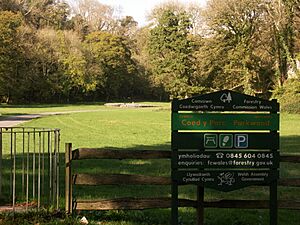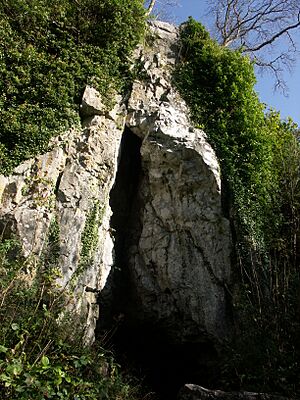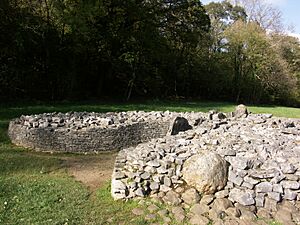Parc le Breos facts for kids
Parc le Breos was a large medieval deer park located in the south of the Gower Peninsula in Wales. It was about 8 miles (12.9 km) west of Swansea. This park was an enclosed, oval area. It was about 6.7 miles (10.8 km) around and covered about 2,000 acres (809 ha).
Parc le Breos was created in the 1220s CE. It was established by John de Braose. He was a powerful lord from the de Braose family. He was also the husband of Margaret Ferch Llywelyn, who was the daughter of Llywelyn the Great. The park was mainly used for raising deer. It also earned money from grazing animals, feeding pigs, and selling wild honey, ferns, and dead wood. There were also rabbit warrens in the park.
The park's edge was originally marked by a wooden fence. This fence, called a pale, sat on top of an earth bank with a ditch. Some parts of this old fence still exist today.
Long before the deer park, people lived in the area of Parc le Breos. Prehistoric finds and an Iron Age enclosure show that humans have settled here since very early times.
Contents
A Look Back: History of Parc le Breos
The land that became Parc le Breos has been home to people for a very long time.
Early Humans and the Cathole Cave
The Cathole Cave is a steep cave made of limestone. It is about 50 feet (15 m) above the floor of a dry, narrow gorge. This gorge is now known as the Parc le Breos Cwm valley. People used this cave as a shelter. Mesolithic hunters used it, and later, Neolithic people used it as a place to keep bones.
The cave is a deep, triangular crack in the hillside. It has two entrances. Outside the larger entrance, there is a natural flat area. Digs in the cave found ancient tools. Some tools might be from around 28,000 years ago. Other tools from the Upper Palaeolithic period are about 12,000 years old. Animal bones found with these tools show what the climate was like back then. These included bones of red fox, Arctic fox, brown bear, and possibly reindeer. Bones of larger animals like mammoth and woolly rhinoceros were also found.
The Ancient Burial Place: Parc Cwm Long Cairn
In 1869, workers digging for road stone found an early cromlech. A cromlech is an ancient stone structure. This one was built around 5,850 years ago. It is now called Parc Cwm long cairn or Parc le Breos burial chamber. It is about 200 yards (183 m) south of The Cathole Cave.
Later that year, archaeologists dug up the site. They found human bones from at least 40 people. They also found animal remains and Neolithic pottery. In 1937, this cromlech was identified as a Severn-Cotswold tomb. These are large stone tombs. Parts of it were fixed up after another dig in 1960–1961.
Around 6,000 years ago, people in North-West Europe changed their way of life. They stopped being hunter-gatherers and started farming. This was called the Neolithic Revolution. However, studies of the human bones from this tomb show that people used it for up to 800 years. The people buried there were still hunter-gatherers or herders, not farmers.
The cromlech is a trapezoid-shaped pile of stones. It is about 72 feet (22 m) long and 43 feet (13 m) wide at its widest point. A low dry-stone wall holds the stones in place. The top part of the cromlech and its earth covering are now gone.
A bell-shaped forecourt faces south. This courtyard leads to a central passage. This passage is lined with limestone slabs standing on end. Human remains were placed in two pairs of stone rooms leading off the passage. It is thought that bodies might have been placed in nearby caves first. Once they had decomposed, the bones were then moved to the tomb.
Other Ancient Finds
The Llethryd Tooth Cave is another important site. It is a limestone cave about 1,500 yards (1.4 km) north-northwest of the Parc Cwm long cairn. This cave was rediscovered in 1961. Inside, cavers found human bones. A dig in 1962 found the bones of six adults and two children. These bones date back to the Early Bronze Age. Other finds included pottery, knives, and animal bones. These animal bones were from domesticated animals, including cats and dogs.
From Woodland to Deer Park
The area of Parc le Breos was once woodland. It became part of the Kingdom of Deheubarth around 920 CE. Later, in 1100, Henry de Beaumont took control of the area. He became the Lord of Gower.
In 1215, Rhys Gryg took over the peninsula. But in 1220, he gave the area to the English. This happened on the orders of Llywelyn ap Iorwerth. Soon after, Parc le Breos was created as a deer park.
The Act of Union in 1536 made the Lordship of Gower part of the historic county of Glamorgan.
In the 1800s, a Hunting Lodge was built. It is about 1,200 yards (1.1 km) northeast of Parc Cwm long cairn. Today, it is a hotel and a place for pony trekking (horse riding). It is still called Parc le Breos.
Lunnon: From Park to Farm
The eastern part of Parc le Breos became a large farm. This happened around the late 1200s. It was known as a grange, which was a type of farm owned by a lord or monastery. An old record from 1337–1338 mentions it as 'Grangia de Lunan'. The village of Lunnon would later be built here.
By the mid-1500s, the rest of the park also changed. It stopped being a deer park and became farmland. All but the limestone gorge and about 500 acres of woodland were divided into three farms.
Visiting Parc le Breos Today
The remaining parkland of Parc le Breos is now part of Coed y Parc. This is about 7.5 miles (12 km) west-southwest of Swansea, Wales. It is in the southern part of the central Gower Peninsula. It lies between the villages of Llanrhidian and Bishopston. The closest village is Parkmill, which is about 1 mile (1.6 km) to the southeast.
Coed y Parc is owned and managed by Natural Resources Wales. You can walk there for free. There is also free parking for 12–15 cars. The parking area is about 750 feet (229 m) from the site.
Across the lane from the car park, there is a kissing gate. It is wide enough for a wheelchair to pass through. This gate leads to an asphalt path. The path runs past the cromlech and along the gorge. This allows flat, easy access for people with disabilities. You can get within about 10 feet (3 m) of the cromlech. The Parc Cwm long cairn is looked after by Cadw. This is the Welsh government's division for historic sites.




